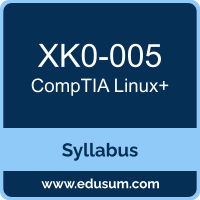 Use this quick start guide to collect all the information about CompTIA Linux+ (XK0-005) Certification exam. This study guide provides a list of objectives and resources that will help you prepare for items on the XK0-005 CompTIA Linux+ exam. The Sample Questions will help you identify the type and difficulty level of the questions and the Practice Exams will make you familiar with the format and environment of an exam. You should refer this guide carefully before attempting your actual CompTIA Linux Plus certification exam.
Use this quick start guide to collect all the information about CompTIA Linux+ (XK0-005) Certification exam. This study guide provides a list of objectives and resources that will help you prepare for items on the XK0-005 CompTIA Linux+ exam. The Sample Questions will help you identify the type and difficulty level of the questions and the Practice Exams will make you familiar with the format and environment of an exam. You should refer this guide carefully before attempting your actual CompTIA Linux Plus certification exam.
The CompTIA Linux+ certification is mainly targeted to those candidates who want to build their career in Network domain. The CompTIA Linux+ exam verifies that the candidate possesses the fundamental knowledge and proven skills in the area of CompTIA Linux Plus.
CompTIA Linux+ Exam Summary:
| Exam Name | CompTIA Linux+ |
| Exam Code | XK0-005 |
| Exam Price | $390 (USD) |
| Duration | 90 mins |
| Number of Questions | 90 |
| Passing Score | 720 (on a scale of 100-900) |
| Books / Training | CompTIA CertMaster Learn |
| Schedule Exam | Pearson VUE |
| Sample Questions | CompTIA Linux+ Sample Questions |
| Practice Exam | CompTIA XK0-005 Certification Practice Exam |
CompTIA XK0-005 Exam Syllabus Topics:
| Topic | Details |
|---|---|
System Management - 32% |
|
| Summarize Linux fundamentals. |
- Filesystem Hierarchy Standard (FHS)
- Basic boot process
- Kernel panic
- Basic package compilation from source
- Storage concepts
- Listing hardware information
|
| Given a scenario, manage files and directories. |
- File editing
- File compression, archiving, and backup
- File metadata
- Soft and hard links
- File and directory operations
|
| Given a scenario, configure and manage storage using the appropriate tools. |
- Disk partitioning
- Mounting local and remote devices
- Filesystem management
- Monitoring storage space and disk usage
- Creating and modifying volumes using Logical Volume Manager (LVM)
- Inspecting RAID implementations
- Storage area network (SAN)/network-attached storage (NAS)
- Storage hardware
|
| Given a scenario, configure and use the appropriate processes and services. |
- System services
- Scheduling services
- Process management
|
| Given a scenario, use the appropriate networking tools or configuration files. |
- Interface management
- Name resolution
- Network monitoring
- Remote networking tools
|
| Given a scenario, build and install software. |
- Package management
- Sandboxed applications
- System updates
|
| Given a scenario, manage software configurations. |
- Updating configuration files
- Configure kernel options
- Configure common system services
- Localization
|
Security - 21% |
|
| Summarize the purpose and use of security best practices in a Linux environment. |
- Managing public key infrastructure (PKI) certificates
- Certificate use cases
- Authentication
- Linux hardening
|
| Given a scenario, implement identity management. |
- Account creation and deletion
- Account management
|
| Given a scenario, implement and configure firewalls. |
- Firewall use cases
- Common firewall technologies
- Key firewall features
|
| Given a scenario, configure and execute remote connectivity for system management. |
- SSH
- Executing commands as another user
|
| Given a scenario, apply the appropriate access controls. |
- File permissions
- Security-enhanced Linux (SELinux)
- AppArmor
- Command-line utilities
|
Scripting, Containers, and Automation - 19% |
|
| Given a scenario, create simple shell scripts to automate common tasks. |
- Shell script elements
- Common script utilities
- Environment variables
- Relative and absolute paths |
| Given a scenario, perform basic container operations. |
- Container management
- Container image operations
|
| Given a scenario, perform basic version control using Git. |
- clone - push - pull - commit - add - checkout - branch - tag - gitignore |
| Summarize common infrastructure as code technologies. |
- File formats
- Utilities
- Continuous integration/continuous deployment (CI/CD)
- Advanced Git topics
|
| Summarize container, cloud, and orchestration concepts. |
- Kubernetes benefits and application use cases
- Single-node, multicontainer use cases
- Container persistent storage
- Service mesh
- Container registries |
Troubleshooting - 28% |
|
| Given a scenario, analyze and troubleshoot storage issues. |
- High latency
- Low throughput
- Capacity issues
- Filesystem issues
- I/O scheduler
- Mount option problems |
| Given a scenario, analyze and troubleshoot network resource issues. |
- Network configuration issues
- Firewall issues
- Bandwidth limitations
- Name resolution issues
- Testing remote systems
|
| Given a scenario, analyze and troubleshoot central processing unit (CPU) and memory issues. |
- Runaway processes - Zombie processes - High CPU utilization - High load average - High run queues - CPU times
- CPU process priorities
- Memory exhaustion
- Out of memory (OOM)
- Swapping
|
| Given a scenario, analyze and troubleshoot user access and file permissions. |
- User login issues - User file access issues
- Password issues |
| Given a scenario, use systemd to diagnose and resolve common problems with a Linux system. |
- Unit files
- Common problems
|
To ensure success in CompTIA Linux Plus certification exam, we recommend authorized training course, practice test and hands-on experience to prepare for CompTIA Linux+ (XK0-005) exam.
